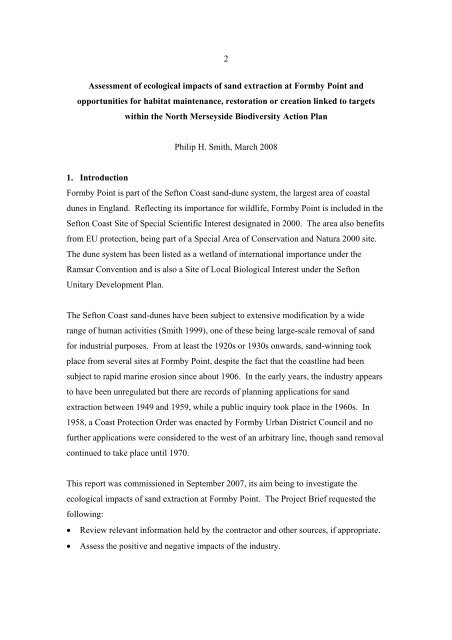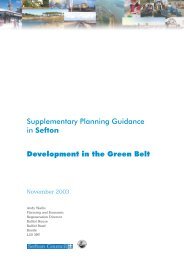The impact of sand extraction at Formby Point ... - Sefton Council
The impact of sand extraction at Formby Point ... - Sefton Council
The impact of sand extraction at Formby Point ... - Sefton Council
You also want an ePaper? Increase the reach of your titles
YUMPU automatically turns print PDFs into web optimized ePapers that Google loves.
2<br />
Assessment <strong>of</strong> ecological <strong>impact</strong>s <strong>of</strong> <strong>sand</strong> <strong>extraction</strong> <strong>at</strong> <strong>Formby</strong> <strong>Point</strong> and<br />
opportunities for habit<strong>at</strong> maintenance, restor<strong>at</strong>ion or cre<strong>at</strong>ion linked to targets<br />
within the North Merseyside Biodiversity Action Plan<br />
Philip H. Smith, March 2008<br />
1. Introduction<br />
<strong>Formby</strong> <strong>Point</strong> is part <strong>of</strong> the <strong>Sefton</strong> Coast <strong>sand</strong>-dune system, the largest area <strong>of</strong> coastal<br />
dunes in England. Reflecting its importance for wildlife, <strong>Formby</strong> <strong>Point</strong> is included in the<br />
<strong>Sefton</strong> Coast Site <strong>of</strong> Special Scientific Interest design<strong>at</strong>ed in 2000. <strong>The</strong> area also benefits<br />
from EU protection, being part <strong>of</strong> a Special Area <strong>of</strong> Conserv<strong>at</strong>ion and N<strong>at</strong>ura 2000 site.<br />
<strong>The</strong> dune system has been listed as a wetland <strong>of</strong> intern<strong>at</strong>ional importance under the<br />
Ramsar Convention and is also a Site <strong>of</strong> Local Biological Interest under the <strong>Sefton</strong><br />
Unitary Development Plan.<br />
<strong>The</strong> <strong>Sefton</strong> Coast <strong>sand</strong>-dunes have been subject to extensive modific<strong>at</strong>ion by a wide<br />
range <strong>of</strong> human activities (Smith 1999), one <strong>of</strong> these being large-scale removal <strong>of</strong> <strong>sand</strong><br />
for industrial purposes. From <strong>at</strong> least the 1920s or 1930s onwards, <strong>sand</strong>-winning took<br />
place from several sites <strong>at</strong> <strong>Formby</strong> <strong>Point</strong>, despite the fact th<strong>at</strong> the coastline had been<br />
subject to rapid marine erosion since about 1906. In the early years, the industry appears<br />
to have been unregul<strong>at</strong>ed but there are records <strong>of</strong> planning applic<strong>at</strong>ions for <strong>sand</strong><br />
<strong>extraction</strong> between 1949 and 1959, while a public inquiry took place in the 1960s. In<br />
1958, a Coast Protection Order was enacted by <strong>Formby</strong> Urban District <strong>Council</strong> and no<br />
further applic<strong>at</strong>ions were considered to the west <strong>of</strong> an arbitrary line, though <strong>sand</strong> removal<br />
continued to take place until 1970.<br />
This report was commissioned in September 2007, its aim being to investig<strong>at</strong>e the<br />
ecological <strong>impact</strong>s <strong>of</strong> <strong>sand</strong> <strong>extraction</strong> <strong>at</strong> <strong>Formby</strong> <strong>Point</strong>. <strong>The</strong> Project Brief requested the<br />
following:<br />
• Review relevant inform<strong>at</strong>ion held by the contractor and other sources, if appropri<strong>at</strong>e.<br />
• Assess the positive and neg<strong>at</strong>ive <strong>impact</strong>s <strong>of</strong> the industry.















